
Mission San Francisco de Asís, commonly known as Mission Dolores, is a Spanish Californian mission and the oldest surviving structure in San Francisco. Located in the Mission District, it was founded on October 9, 1776, by Padre Francisco Palóu and co-founder Fray Pedro Benito Cambón, who had been charged with bringing Spanish settlers to Alta California and with evangelizing the local indigenous Californians, the Ohlone. The present mission building was the second structure for the site and was dedicated in 1791.

This is intended to be a complete list of the properties and districts on the National Register of Historic Places in San Francisco, California, United States. Latitude and longitude coordinates are provided for many National Register properties and districts; these locations may be seen together in an online map.

The Pacific-Union Club is a social club located at 1000 California Street in San Francisco, California, at the top of Nob Hill. It is considered to be the most elite club of the West Coast, and one of the most elite clubs in the United States, along with the Knickerbocker Club in New York, the Metropolitan Club in Washington D.C., and the Somerset Club in Boston.

Rincon Hill is a neighborhood in San Francisco, California. It is one of San Francisco's many hills, and one of its original "Seven Hills." The relatively compact neighborhood is bounded by Folsom Street to the north, the Embarcadero to the east, Bryant Street on the south, and Essex Street to the west. Named after Rincon Point that formerly extended into the bay there, Rincon Hill is located just south of the Transbay development area, part of the greater South of Market area. The hill is about 100 feet tall.
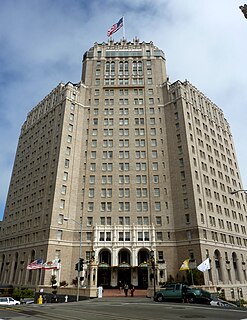
The InterContinental Mark Hopkins San Francisco is a luxury hotel located at the top of Nob Hill in San Francisco, California. The hotel is managed by the InterContinental Hotels Group. The chain operates over 5,000 hotels and resorts in approximately 75 nations. The Mark Hopkins is the oldest InterContinental in the United States.
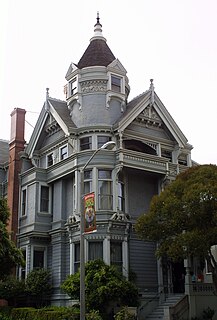
The Haas–Lilienthal House is a historic building located at 2007 Franklin Street in San Francisco, California, United States, within the Pacific Heights neighborhood. Built in 1886 for William and Bertha Haas, it survived the 1906 San Francisco earthquake and subsequent fire. The house is a San Francisco Designated Landmark and is listed on the U.S. National Register of Historic Places. It is the city's only intact Victorian era home that is open regularly as a museum, complete with period furniture and artifacts. As of 2016, it received over 6,500 visitors annually.
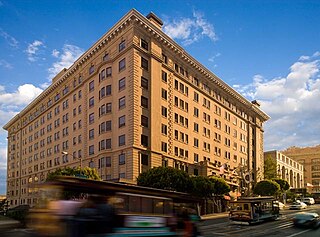
The Stanford Court Hotel is a historic 393-room hotel located at 905 California Street on Nob Hill in San Francisco, California. The hotel sits at the intersection of California & Powell St, where the city's cable car lines also intersect.

The Fairmont San Francisco is an AAA Four-Diamond luxury hotel at 950 Mason Street, atop Nob Hill in San Francisco, California. The hotel was named after mining magnate and U.S. Senator James Graham Fair (1831–94), by his daughters, Theresa Fair Oelrichs and Virginia Fair Vanderbilt, who built the hotel in his honor. The hotel was the vanguard of the Fairmont Hotels and Resorts chain. The group is now owned by Fairmont Raffles Hotels International, but all the original Fairmont hotels still keep their names.
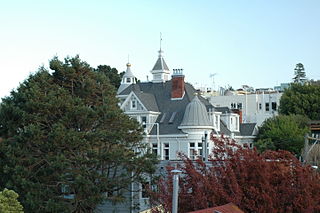
The Alfred E. Clarke Mansion, also known as the Caselli Mansion, Nobby Clarke's Castle and Nobby Clarke's Folly, is a mansion at 250 Douglass Street on the corner of Caselli Avenue in Eureka Valley, San Francisco, California. Built in 1891 by Alfred "Nobby" Clarke, it has been a hospital and is now an apartment building. It became a San Francisco Designated Landmark in 1975.

Victoria Mansion, also known as the Morse-Libby House or Morse-Libby Mansion, is a landmark example of American residential architecture located in downtown Portland, Maine, United States. The brownstone exterior, elaborate interior design, opulent furnishings and early technological conveniences provide a detailed portrait of lavish living in nineteenth-century America. It was declared a National Historic Landmark in 1971 for its architectural significance as a particularly well-preserved Italianate mansion.

The Old Cathedral of St. Mary of the Immaculate Conception is a proto-cathedral and parish of the Roman Catholic Church located at 660 California Street at the corner of Grant Avenue in the Chinatown neighborhood of San Francisco, California. It was built in 1854 in the Gothic Revival style, and was made a Designated San Francisco Landmark on April 11, 1968.

The James R. Browning U.S. Court of Appeals Building is a historic post office and courthouse building located at San Francisco, California. It is a courthouse for the United States Court of Appeals for the Ninth Circuit. Completed in 1905 as the U.S. Courthouse and Post Office, it was intended to represent the affluence and increasing importance of the United States as it became a world power. The building survived both the 1906 San Francisco earthquake and the 1989 Loma Prieta earthquake.
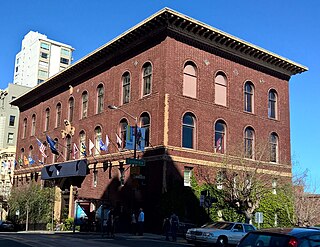
The University Club of San Francisco is a private social club located atop Nob Hill in San Francisco, California. Notable members have included President Herbert Hoover and conservationist John Muir.
Walter Danforth Bliss (1874-1956) was an American architect from California. Many of his buildings are listed on the National Register of Historic Places.
Augustus Laver was a Canadian architect. He worked for Thomas Stent and later designed extensive alterations and additions to Ottawa's Russell Hotel, as well as East Block and West Block on Parliament Hill. He entered the 1866 competition to design the New York State capitol at Albany and was awarded one of the premiums, participated with Thomas Fuller, and Arthur Delavan Gilman in planning a revised design. In Albany he partnered with Fuller, but after controversy neither partner saw the project to completion. In 1871 Stent and Laver won the competition to design the new city hall and law courts for San Francisco. Eight years after Laver's death, the unfinished building was destroyed in the fire following the 1906 earthquake.

Jackson Street is a street in San Francisco, California, running through the Pacific Heights, Nob Hill, Chinatown and Jackson Square districts of the city. It runs between Pacific Avenue and Washington Street, beginning at Arguello Boulevard to the south of the Presidio Golf Course and ending at Drumm Street, to the west of Pier 3, near Sydney G. Walton Square.

Nob Hill is a neighborhood of San Francisco, California that is known for its numerous luxury hotels and historic mansions. Nob Hill has historically served as a center of San Francisco's upper class. Nob Hill is among the highest-income neighborhoods in the United States, as well as one of the most desirable and expensive real estate markets in the country.

The Theodore F. Payne House, also known as the Payne Mansion, is a Victorian house in the Lower Pacific Heights neighborhood of San Francisco, California, United States. Built in 1881 and designed by William Curlett in a mix of Stick, Eastlake, and Queen Anne styles, it survived the 1906 San Francisco earthquake and was listed on the National Register of Historic Places in 1980. It has been adapted to house a hotel and a restaurant.
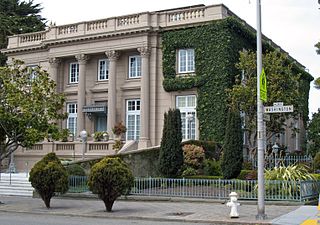
Koshland House, also known as "Le Petit Trianon", is a private residence in the Presidio Heights neighborhood of San Francisco, California. It has been one of San Francisco's most prominent and celebrated homes for over 100 years.

The Old San Francisco Mint is a building that served as the location of the San Francisco branch of the United States Mint from 1874 until 1937. The building is one of the few that survived the great 1906 San Francisco earthquake and resulting fire. It was designated a National Historic Landmark in 1961, and as a California Historical Landmark in 1974.






















